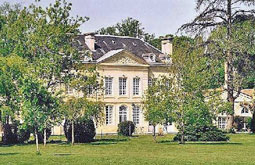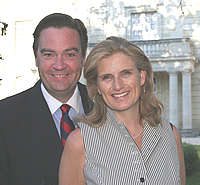 |
| The Independent Traveler's Newsletter PAGE THREE |
 |
| The Independent Traveler's Newsletter PAGE THREE |
| DISCOVER
SELECT PARIS SUBURB TREASURES: Meudon
by Arthur Gillette There
is so much to see and learn about in the French capital that many (most?)
visitors
WESTWARD HO… …to Meudon, which you can reach by suburban rail from the Gare Montparnasse in all of a dozen minutes. Its Latin name was something like Melodunum. The dunum part relates to English 'dune' and London's 'don', meaning 'hill' or 'hillock'. And melo? Hmmm . . . something of a mystery there. Some sources say it refers to the honey ('miel' in French, giving us 'mellifluous' in English) that beekeepers produced in Meudon many centuries ago. Others affirm it stems from the yellowish color of much of its soil, which is quite sandy. Perhaps both? In any event, before looking at the ground, when you leave he train station head upwards along Avenue LeCorbeiller for a ten minute climb up the dunum to the public park at the Grande Terrasse, one of the most stupendous vantage points in the Parisian suburbs. A castle was built here in the second half of the 16th century and rebuilt later by Le Vau, who also took part in the construction of Versailles. To support the castle, this Grande Terrasse – no less than fourteen meters high - was constructed as a horizontal projection from the rather steep hillside. It is 260 meters long by 140 meters wide. This is what the Old Castle looked like, viewed in its heyday:
Many of those you can see prancing about in this engraving were not commoners. Meudon’s Old Castle was, in fact, an aristocratic stopover on the main road from Paris to no less a place than Versailles. For reasons my research hasn’t been able to fathom, a New Castle was built just above the Grande Terrasse ca. 1706 by that other major neo-classical architect Mansart. Here is an image of the two neighbors, clearly showing the still-extant gardens created by that other Versailles (and Tuileries) landscape genius Le Nôtre.
The aristocrats were kicked out by the Revolution and Meudon’s Old Castle was used for artillery experiments. One of them went awry in 1795, and the Castle burned to the ground. As for the New Castle, during the Franco-Prussian war it was occupied by the enemy and caught fire in 1871. Its vestiges were recycled at the end of the 19th century as an astronomical observatory, which it remains to this day.
So,
now you have the Grande Terrasse pretty much to yourself for a pleasant
stroll. Not to forget an incredible view of Paris. But don’t
let yourself by totally mesmerized by the Eiffel Tower, Invalides &
Co. The Grande Terrasse was designed as the center of an enthralling Grande
Perspective several kilometers long. Much of it is still visible
(or at least guessable) today, viewed from one end and the other of the
Grande Terrasse. A plan is now afoot to restore as much as
possible of the Grande Perspective. And here is an image of what it might
look like.
The Grande Terrasse with Views of Paris
Now let yourself be tempted to follow what’s left of the Grande Perspective. Running from just below the observatory end of the Terrasse, road will take you to the right of the large hexagonal lake you see in the reconstitution (it still exists!) and on for a pleasant stroll in the Meudon National Forest. At the base of the Green Carpet you can lunch on the terrace (or, if it’s cold, inside) of a homey – no electricity! – little restaurant called Le Rendez-vous des Pêchers. Back in central Meudon you can visit another historical monument, a kind of mini-castle built in the 16th century by royal physician Ambroise Paré and later lived in by Molière’s widow, Armande Béjart. Today it houses the Municipal Museum (11, rue des Pierres). In addition to collections presenting the town’s history, it has a garden that hosts the only vineyard left in Meudon, which until World War II produced much wine, not to forget some very avant-garde sculptures. In fact, in addition to its historical attractions Meudon has played quite a role in modern esthetic creation. It was here, for example, that a Sunday party sculptor, Antoine Bourdelle, met innovative American dancer Isadora Duncan, who was teaching courses at a Meudon hotel. She soon modeled for his allegorical bas relief La Dance which still graces the early Art Déco façade of the 1913 Théâtre des Champs Elysées in Paris. [For a visual preview go to the web site for the Ville de Meudon at http://www.ville-meudon.fr/culture/musee-dart-et-dhistoire and click on Voir le film de presentation.]
It is perhaps not surprising that, at about the same time, Igor Stravinsky and Claude Debussy gave, in Meudon, a first private performance of the former’s rather violently innovative Rite of Spring. When, also in 1913, it was publicly premièred at the Théâtre des Champs Elysées – danced by a "lightly clad" Vaslav Nijinsky – there was scandal and a riot!
Have you found this article prejudiced in favor of Meudon? Well, perhaps. You see, I live there! Contact Arthur
Gillette at armedv@aol.com for information
about his
|
2011
Bordeaux Harvest Tour

Château Coulon Laurensac 
Be one of the lucky ones to enjoy an all-inclusive wine tour of Bordeaux for 6 days and 5 nights. The Bordeaux Harvest Tour includes visits to top châteaux such as Haut Brion, Pichon Baron and Château Yquem, and meals will be served in Bordeaux châteaux and two-star Michelin restaurants. Best
of all, you will have accommodations in the 18th century Château
Coulon Laurensac, the home of your English-speaking hosts, Ronald and
Margaret Rens. Ronald is your expert guide; he is a Wine Master and
certified wine expert. Deluxe transportation is provided for the
entire stay, and the small groups of no more than six allows personal attention
throughout the week.
When? September 26 to October 1, 2011. Please contact Ronald Rens directly by clicking here. He will let you know promptly if the remaining spaces on this tour are still available. Tour Price? € 3995 per person, double/twin occupancy. One single room available. (Includes all taxes, tips and gratuities.)
|
|
Châteaux by Invitation Only - Immerse yourself in the very private world of French aristocracy as the private guests of Comte and Comtesse de Vanssay, the 20th generation to have resided at Chateau de La Barre, surrounded by a 100-acre private park with fragrant gardens at the entrance to the famous Loire Valley. This family château achieves a harmonious balance between refined, understated luxury, and modern comfort. In the reception rooms and bedrooms, precious XVIIIth century furnishings are brought to life by luscious designer fabrics reflecting the warm hospitality and joie de vivre prevalent throughout. Guy and Marnie open up a way of life for virtuoso guests, with exclusive receptions at private châteaux and gardens of their region, where 600 years of the rich cultural history of a family and a country are entwined. During your 5- to 6-night (6- to 7-day) stay, which depends upon options available and selected, you will be hosted by at least five of the owners themselves for exclusive receptions and their private châteaux, gardens and clubs. These visits will include:
There is so much more to each day's itinerary, we do not have space to cover it all here. But, here is a detailed description of Day 1 of the Tour. . . the others are just as exciting: Day 1: Chartres and arrival at Chateau de La Barre English-speaking chauffeur pick up at Paris Charles de Gaulle airport Drive
to Chateau de La Barre (a 2-hour drive), via Chartres cathedral.
On to Château
de Montmirail, XIIth-XVIIth century, former residence of Louis XIV's daughter.
Welcome to
Château de La Barre by Comte and Comtesse, Guy and Marnie de Vanssay.
Tour of the Château with Guy de Vanssay. Informal wine and cheese tasting supper served in the pièce à feu by the monumental XIVth century fireplace.
As you can see, there many things included in each day that the average tourist would not have the opportunity to experience. For complete details, schedules of upcoming tours, a daily itinerary and prices, please contact publisher@franceonyourown.com and put 'Invitation' in the subject line. [Mouse over photos on this page for credits and further descriptions.] |
|
|